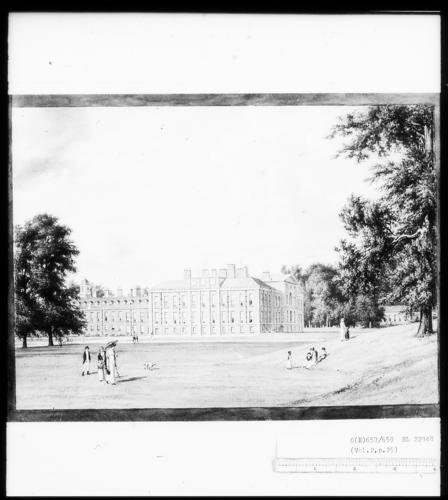William Westall (1781-1850)
Kensington Palace: The south and east fronts 1819
Watercolour and bodycolour over pencil | 20.5 x 28.3 cm (sheet of paper) | RCIN 922148
-
Kensington Palace was much used by sovereigns from William III to George II, and the majority of the miniatures, drawings and historical jewels in the Collection appear to have been at Kensington at the time of George III’s accession. However, they were soon transferred - with many of the finer paintings - to Buckingham House and by 1795 Kensington was described as ‘entirely forsaken’. Pyne considered that ‘as Kensington Palace is so rarely visited, it would be well to select the best remaining graphic works, particularly the portraits, to add to the interest of the other royal collections’. His text conceals the fact that Kensington was the home of the Prince Regent’s estranged wife, Caroline of Brunswick, between 1808 and 1813, and of two of George III’s sons - Prince Edward, Duke of Kent, from 1804, and Prince Augustus, Duke of Sussex, from 1810. It was at Kensington that the Duke of Kent’s only child, the future Queen Victoria, was born in May 1819, the month in which this view was published. (At this period the Kents occupied rooms on the first floor in the south-east portion of the palace, shown here.)
The core of Kensington Palace is the early seventeenth-century villa purchased by William III from the Earl of Nottingham in 1689. Over the following thirty years the villa was converted to the palace that has survived largely unchanged to this day. Sir Christopher Wren was initially in charge of the work but his assistant Nicholas Hawksmoor gradually assumed responsibility. The first phase of work, from 1689, included the Stone Gallery (to the left in this view). In the 1690s the main 11-bay palace block was added, with the principal rooms at second-floor level; in this view all but the two most easterly (corner) windows on the second floor light the King’s Gallery. At the same period a series of apartments was added to the north for Mary II, who died in her newly completed Bedchamber at Kensington in 1694. On the east front, the pediment marks the suite of three rooms (including the Cupola Room) built for George I, c.1718.
Catalogue entry adapted from George III & Queen Charlotte: Patronage, Collecting and Court Taste, London, 2004Provenance
Probably acquired by George IV
-
Creator(s)
Acquirer(s)
-
Medium and techniques
Watercolour and bodycolour over pencil
Measurements
20.5 x 28.3 cm (sheet of paper)
Other number(s)
RL 22148Alternative title(s)
Kensington Palace from the south west.









